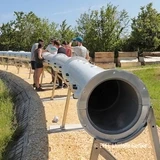A gigantic eye open to the Universe

An Extremely Large Telescope (ELT) has been growing on top of a Chilean Mountain. The European South Observatory (ESO) has been leaning on a multitude of partners, among them Procon Systems, to create this installation of all superlatives.
The more light a telescope captures, the better it “sees”. Therefore, billions are spent on building ever larger telescopes. With its almost 40m diameter, the ESO’s Extremely Large Telescope, under construction in Chile, will mark a new record. Everything about it is astronomical.
The ELT will capture twenty times more light than the current largest installations (of the Very Large Telescope range), which is 100 million times more than a human eye. More than enough to delight Galileo, the father of astronomical observation who discovered satellites around Jupiter through a 3 times magnifying instrument.
The ELT is composed of four Zerodur glass ceramic mirrors and one in Silicone Carbide, SiC. Of various sizes, forms and roles, they will work in unison to deliver images of the universe with greater precision and clarity than ever before. They will be held by a structure (with 30 million nuts) sheltered in an 80m high and 88m diameter hemispherical dome.
The main mirror marries extremes: a 39m, 132-ton Zerodur monster, whose 798 segments will be aligned with a precision of tenths of microns.
Whether giants or not, telescopes become myopic when even the slightest disturbance occurs. Preventing and controlling require an array of scientific, technological and industrial solutions. The mirrors’ design and polishing, as complex as they may be, constitute only one element.
The choice of the location is another and the top of the Cerro Armazones provided many advantages. Right in the middle of the Atacama Desert, which has a hyper-arid climate offering an annual 350 cloudless nights. The not-too-distant ocean mitigates temperature variations. Isolation limits disturbance caused by human activities (air- and light pollution). Moreover, the area is well-known to the ESO, since its Cerro Paranal VLT stands at about 20km as the crow flies.
The altitude of the site, at 3000m, reduces disturbances due to atmospheric turbulence, but not completely. Such turbulence changing rapidly, it may cause aberrations that must be corrected rapidly. Large mirrors not being as agile, small, flexible “deformable mirrors” are being used. To correct the blur caused by local atmosphere, it is measured with the help of a reference star, bright and close enough to the object being studied. To make sure that there is such a star, it is created: astronomers send a powerful laser beam into the upper atmosphere. The ELT will have 8 such lasers.
This solution, already used with the neighbouring VLT, is called adaptive optics. It will make it possible for the new ground-based telescope to capture images sixteen times sharper than the Hubble Space Telescope.
Another major, intrinsic disturbance: the enormous weight of the mirrors exerts incredible force that deforms their surface. In order to correct this, the ESO uses another solution, active optics: an array of electric and hydraulic actuators that modify mass distribution, to counter local surface distortions.
Once “That obscure clarity that falls from the stars” is captured, corrected and stabilised, the instruments step in. Several ultra-sophisticated cameras and spectrographs transform the visible and infrared light into information.
The ELT will make it possible to observe better than ever all the “grails” of astronomy and cosmology: extra-solar planets, the origin of the galaxies (it will “see” them 380.000 years after the Big Bang (a blink of the eye on a cosmic scale), as well as their evolution, supermassive blackholes, potential traces of life elsewhere in the Universe… enough to provide quite a few answers and to raise new questions, since every new large telescope brings its unexpected findings.
Such objectives would be impossible to achieve without large-scale cooperation.
Founded in 1962, the European South Observatory (ESO) is an intergovernmental organization involving 16 Member States. The mission of the ESO is to build and operate world-class ground-based astronomical facilities, as well as to foster cooperation in astronomy. The ESO has its headquarters near Munich in Germany, and it operates three observing sites in Chile: La Silla, Paranal and Chainantor. The ESO’s ELT is currently being built on Cerro Armazones, near Paranal.
Developing these massive installations, the instruments they will incorporate and the scientific programmes they will serve involves hundreds of public and private institutions. The construction of the ESO’s ELT in Chile, for instance, implies over forty industrial contracts worth more than 500.000 euros each.
Among the partners, Spanish company Procon Systems was commissioned for the assembly, integration and verification of 132 electronic cabinets which will house electronic components for the control, communication and power supply of ELT’s primary mirror. It is for the second time that ESO has turned to Procon, as they have already contributed to the revision of VLT’s control system.
The equipment assembled by Procon systems is fitted with LEMO solutions. It is not a first-time for the Swiss group, as its connectors had already been selected for several telescopes, including the DAG in Turkey (CONNECTED N°8) which should be inaugurated this year. There will be over 10.000 LEMO connectors on the American Thirty Meter Telescope (CONNECTED N°11), in construction in Hawaii.
In the meantime, in the Martian-like landscape of Cerro Armazones, the construction of the ESO’s Extremely Large Telescope is progressing. Since 2014, the mountain top has been reduced by 18m in height and 220.000m3 rocks have been removed, freeing up a flat surface of 150m by 300m. The impressive foundations have been laid and in 2021, the building of the structure and the dome began. It should be finished by 2025. Once the ESO’s ELT sees its “first light” (first capture of photons from the sky) in 2027 it will become the world’s largest eye on the sky opened by humankind.
Follow ELT’s construction: https://elt.eso.org/about/webcams


